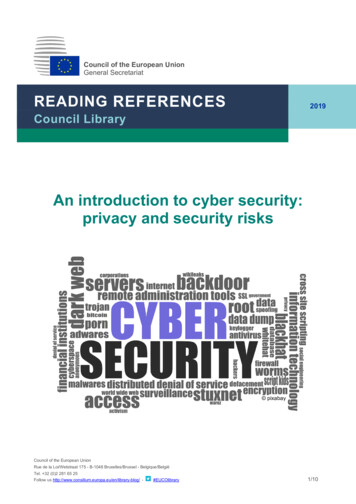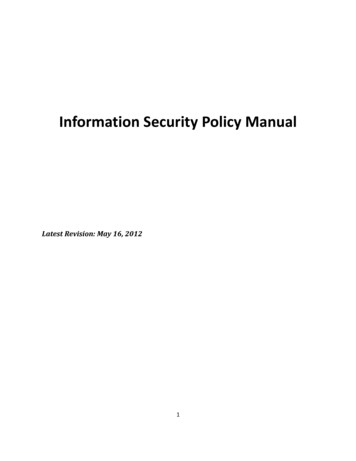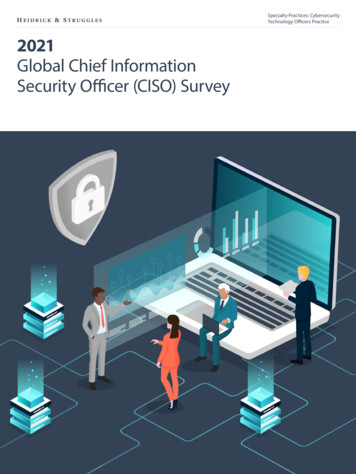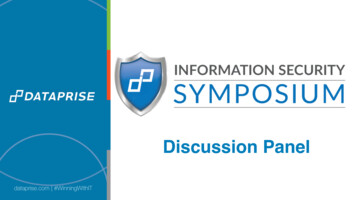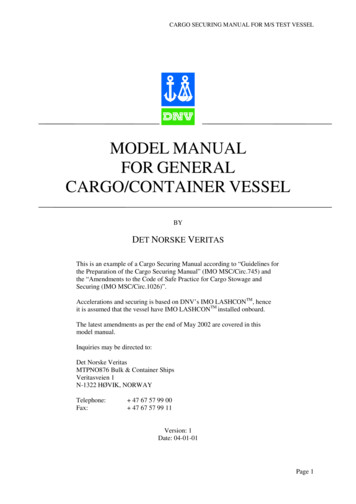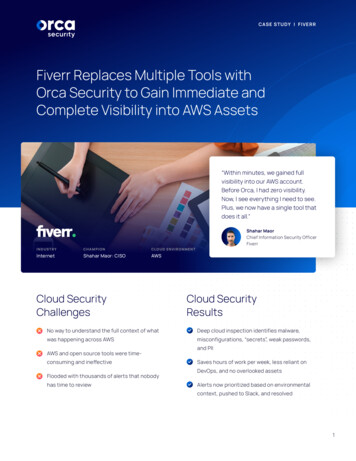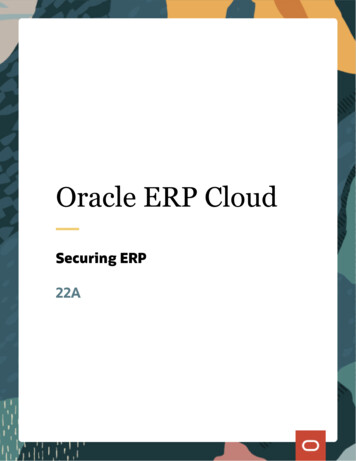
Transcription
CISO’s Guide to SecuringSharePointTsvika KleinImperva
Introduction to SharePoint One of the fastest selling products On its way to being the first 2 billionbusiness 30% year over year growth More than 125 million licenses Over 65,000 customers Revenue comes from ECM, teamcollaborative applications and enterpriseportals Security and rights management is #2add-onSource: point-numbers/2011-10-10
Impact of SharePoint Insecurity“[Investigators] discovered Wget scripts onManning’s computer that pointed to a MicrosoftSharePoint server holding the Gitmo documents.He ran the scripts to download the documents,then downloaded the ones that WikiLeaks hadpublished and found they were the same.”—Wired, Dec 2011Source: ripts-manning/
In the Beginning Internal Access
Food Brings Along AppetiteExternal Web accessInternal AccessPartner access
Major SharePoint DeploymentTypesInternalPortal Uses include SharePoint as a filerepository Only accessible by internal usersCompany IntranetExternalPortal Uses include SharePoint as a filerepository Accessible from the Internet For customers, partners or the publicClient accessInternetWebsite SharePoint as the Web siteinfrastructure Not used as a file repositoryPublic website
Do you use SharePoint forcollaboration with any of thefollowing?Source: SharePoint: Strategies and Experiences, September 2011
Key Issues With SharePointSource: SharePoint: Strategies and Experiences, September 2011
Third-Party AdditionsSource: SharePoint: Strategies and Experiences, September 2011
Have You Shared PrivilegedInfo via SharePoint?No answer;9%No43%Source: NetworkWorld, May 2, 2011Yes48%
Type of Content SharedOtherProprietary 33%Financial22%Source: NetworkWorld, May 2, 2011HR21%Customer Data30%
SharePoint 2010 is Still Missing Functionality–––––Rights managementProper auditingWeb and Database protectionSecurity-centric reportingSecurity-centric policies Bottom line– SharePoint is built for collaboration first– Security comes second.
Native SharePoint SecurityCapabilities“In general, SharePoint involves acomplex set of interactions thatmakes it difficult for security teamsto know if all their concerns arecovered.”—Burton Group, 2010
Key SharePoint Security Challenges- CONFIDENTIAL -CONFIDENTIAL
#1: Getting Permissions Right Summary:– Microsoft’s advice begins with permissions– “Content should not be available to all users information should be accessible on a needto-know basis” Why challenging?––––Difficult to track and maintainConstantly changeNo automation or aggregationNeed to involve data owners. What is Required?– Automated permissions review tools– Baseline and change reports– Simplify rights reviews
SharePoint Permission HierarchyApplication PolicySite CollectionTop-Level SiteListSharePoint ApplicationSub-SiteFileFileFarm and Local AdministratorsApplication Policy PermissionsSite Collection AdminsSharePoint GroupsAD GroupsUsersSite CollectionTop-Level SiteSite CollectionAdministratorsLibraryFolder ListItemItem
User Rights Management:Doing it Right Aggregate user rights across systems Detect excessive rights, reduceaccess to business-need-to-know Identify dormant users Identify and involve data owners Formalize and automate approvalcycle
Finding Excessive PermissionsFocus on access to HIPAAregulated dataWhat departments have access?Why does G&A have access?Who are the users?What type of access do they have?How did they get the access?CONFIDENTIAL20
Automatic Identification ofExcessive RightsShould “Everyone” have access to sensitive data? “Everyone” group literally means all usersAre there any direct user permissions?What rights are not used? Users with access they appear not to need
Identifying Dormant UsersAre there dormant users?Focus on users that are dormant forover 6 monthWho are they and when did theylast access?CONFIDENTIAL22
Reviewing User Rights withData Owners Data owners are ultimately responsible for the protection of data Data owners have due care responsibility in case of any negligent act Data owners should review and manage user rights– Review permission changes– Revoke unauthorized access permissions– Create reports
#2: Compliance Reporting Summary:– If you store business data, you must demonstrate compliance with regulations Why challenging?– Manual process – minimal inherent data audit capability– Native audit trail is not usable/readable– No knowledge of the identity of data owners
#2: Compliance Reporting Summary:– If you store business data, you must demonstrate compliance with regulations Why challenging?– Manual process – minimal inherent data audit capability– Native audit trail is not usable/readable– No knowledge of the identity of data owners What is Required?–––– Human-readable activity auditing and reportingAdd enrichment data to simplify compliance processData owner identificationAudit AnalyticsExample: In August 2011, Bloomberg reported on 300,000 healthcare records thatappeared in an Excel file. No one knows where the file came from, indicating a lack ofauditing.
Full Audit TrailWhenWhoWhereWhat
SharePoint Admins Gone WildMost popular documents eyeballed were those containing the details oftheir fellow employees, 34 per cent, followed by salary – 23 per cent – and30 per cent said "other."
Detailed Analytics for ForensicsFocus on access to financial dataWhat are the primary departmentsaccessing this data?Why are G&A accessing financial data?Who accessed this data?When & what did they access?Who owns this data?
SharePoint Architecture- Direct Access to DBPartnersXSSExcessive RightsAuditThe InternetAuditApplicationServersSQL Injection29External Access toAdmin pages andFailed LoginAttemptsEnterprise UsersUnauthorizedAccessIIS WebServersMS SQLDatabases
#3: Protect Web Applications Summary:– Web attacks are a common threat– 30% of organizations have external-facing SharePoint sites Why challenging?– Need to patch the system frequently– 3rd party add-ons What is Required?– Real-time attack protection– Reputation based protection: malicious IPs, anonymous proxies– Prevent access to the admin pages by external users Example: According to CVE details, XSS is the most commonly reported vulnerability inSharePoint.
Patch ProtectionInfoWorld (2010):“Admins report that a new Microsoft patch is causingSharePoint servers to fall over – and getting them back upisn’t s-51031
What Do Hackers Think?Example: April 2010, Microsoft reveals a SharePoint issueThe vulnerability could allow escalation of privilege (EoP) within theSharePoint site. If an attacker successfully exploits the vulnerability, theperson could run commands against the SharePoint server with theprivileges of the compromised user.Source: ms-SharePoint-Security-Vulnerability-187410/
Google Diggity Project
#4: Monitor and Protect theSharePoint Database Summary:– The SharePoint database holds all configuration and content information– SharePoint administrators have full access to all SharePoint content– Whoever gains direct access to the database have full control on SharePoint Why challenging?– The SQL Server database isn't properly secured.– No activity monitoring and audit capabilities– No built-in database policy prevention What is Required?– Full audit trail of all activity originated from sources other than the applicationservers.– Protection from direct manipulation to the SharePoint internal database
Database ProtectionMicrosoft Support:“Database modifications may results in a unsupporteddatabase ner (Securing SharePoint, February 2009):“Fully audit all SQL Server administrative activities”Security Considerations and Best Practices for Securing SharePoint35
#5: Respond to SuspiciousActivity Summary:– SharePoint is used as a place to share information– Access is granted to internal and external users– Organizations need to balance trust and openness with the ability to detect and alerton suspicious activity Why challenging?– No automated analysis of access activity What is Required?– Policy framework to identify suspicious behavior Example: In the Wikileaks scenario, Manning used an automated process to crawl theSharePoint system and to siphon out available files. A simple policy on occurrences wouldhave alerted if a certain number of files were touched in a short timeframe.
A Checklist to SecuringSharePointGet ahead of all SharePoint deployments Implement a SharePoint governance policy. Define security requirements before deployment Don’t trust native security features. Specify what kind of information can be put in SharePoint.Identify sensitive data and protect it Use search capabilities to identify sensitive data. Secure sensitive data held in files
A Checklist to SecuringSharePointManage User Rights Manage permissions on a need-to-know basis. Identify and delete dormant users Prevent the use of direct permissions to users Avoid managing permissions at the item level Use claims authentication for external users for better control Involve data owners in the review process.Protect Web sites Protect your SharePoint applications from web attacks Log all failed login attempts. Identify suspicious activity Prevent access to admin pages by external users
A Checklist to SecuringSharePointMonitor and Protect the Database Audit all administrative activity. Prevent access from external sources Prevent direct manipulation of the content Check for data leakageEnable auditing for compliance and forensics Review who accessed data, when and what they accessed Identify who owns the data Report on repeated failed login attempts Create compliance reports
Questions
in
SharePoint Implement a SharePoint governance policy. Define security requirements before deployment Don't trust native security features. Specify what kind of information can be put in SharePoint. Get ahead of all SharePoint deployments Use search capabilities to identify sensitive data. Secure sensitive data held in files

